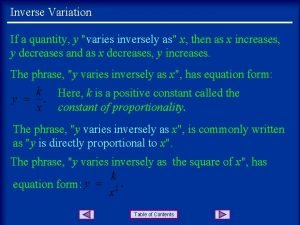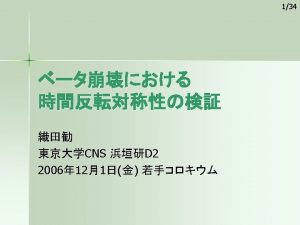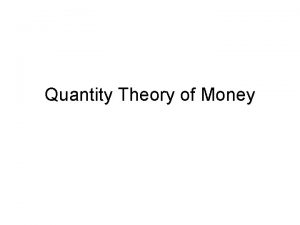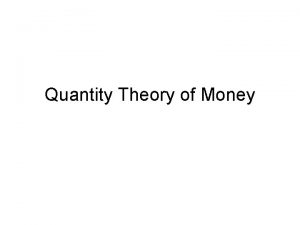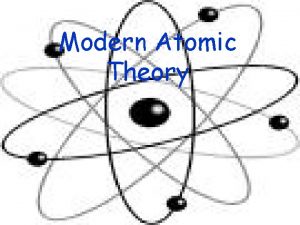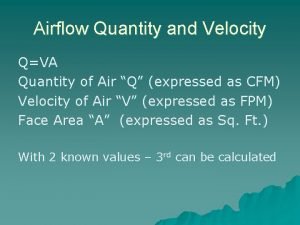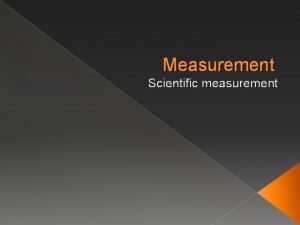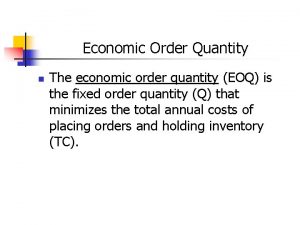Modern quantity theory Introduction The quantity theory of















- Slides: 15

Modern quantity theory

Introduction The quantity theory of money states that the quantity of money is the main determinant of the price level or the value of money. Any change in the quantity of money produces an exactly proportionate change in the price level.

Meaning If the quantity of money is doubled, the price level will also double and the value of money will be one half. On the other hand, if the quantity of money is reduced by one half, the price level will also be reduced by one half and the value of money will be twice.

Definition “Other things remaining unchanged, as the quantity of money in circulation increases, the price level also increases in direct proportion and the value of money decreases and vice versa. ”

Equation of quantity theory PT=MV+ M’ V’ � � � Where P = price level, or 1 IP = the value of money; M = the total quantity of legal tender money; V = the velocity of circulation of M; M’ – the total quantity of credit money; V’ = the velocity of circulation of M; T = the total amount of goods and services exchanged for money or transactions performed by money.

To find out the effect of the quantity of money on the price level or the value of money, we write the equation as P= MV+M’V’


Assumptions � � � � P is passive factor in the equation of exchange which is affected by the other factors. The proportion of M’ to M remains constant. V and V are assumed to be constant and are independent of changes in M and M’. T also remains constant and is independent of other factors such as M, M, V and V. It is assumed that the demand for money is proportional to the value of transactions. The supply of money is assumed as an exogenously determined constant. The theory is applicable in the long run. It is based on the assumption of the existence of full employment in the economy.

Criticisms 1. Truism: According to Keynes, “The quantity theory of money is a truism. ” Fisher’s equation of exchange is a simple truism because it states that the total quantity of money (MV+M’V’) paid for goods and services must equal their value (PT). But it cannot be accepted today that a certain percentage change in the quantity of money leads to the same percentage change in the price level.

2. Other things not equal: The direct and proportionate relation between quantity of money and price level in Fisher’s equation is based on the assumption that “other things remain unchanged”. But in real life, V, V and T are not constant. Moreover, they are not independent of M, M’ and P. Rather, all elements in Fisher’s equation are interrelated and interdependent. For instance, a change in M may cause a change in V.

3. Constants Relate to Different Time: Prof. Halm criticises Fisher for multiplying M and V because M relates to a point of time and V to a period of time. The former is a static concept and the latter a dynamic. It is therefore, technically inconsistent to multiply two non-comparable factors.

4. Fails to Measure Value of Money: Fisher’s equation does not measure the purchasing power of money but only cash transactions, that is, the volume of business transactions of all kinds or what Fisher calls the volume of trade in the community during a year. But the purchasing power of money (or value of money) relates to transactions for the purchase of goods and services for consumption. Thus the quantity theory fails to measure the value of money.

5. Neglects Interest Rate: One of the main weaknesses of Fisher’s quantity theory of money is that it neglects the role of the rate of interest as one of the causative factors between money and prices. Fisher’s equation of exchange is related to an equilibrium situation in which rate of interest is independent of the quantity of money.

6. Static: Fisher’s theory is static in nature because of its such unrealistic assumptions as long run, full employment, etc. It is, therefore, not applicable to a modern dynamic economy.

7. V not Constant: Further, Keynes pointed out that when there is underemployment equilibrium, the velocity of circulation of money V is highly unstable and would change with changes in the stock of money or money income. Thus it was unrealistic for Fisher to assume V to be constant and independent of M.
 Distinguish between scalar and vector
Distinguish between scalar and vector Scalar and vector
Scalar and vector Does a scalar have magnitude
Does a scalar have magnitude Vary inversly
Vary inversly Scalar quantity
Scalar quantity Hát kết hợp bộ gõ cơ thể
Hát kết hợp bộ gõ cơ thể Ng-html
Ng-html Bổ thể
Bổ thể Tỉ lệ cơ thể trẻ em
Tỉ lệ cơ thể trẻ em Chó sói
Chó sói Glasgow thang điểm
Glasgow thang điểm Alleluia hat len nguoi oi
Alleluia hat len nguoi oi Các môn thể thao bắt đầu bằng từ đua
Các môn thể thao bắt đầu bằng từ đua Thế nào là hệ số cao nhất
Thế nào là hệ số cao nhất Các châu lục và đại dương trên thế giới
Các châu lục và đại dương trên thế giới Công của trọng lực
Công của trọng lực



